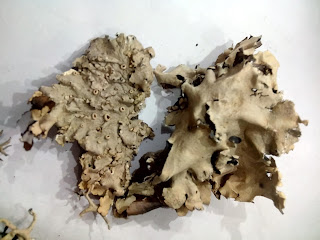LICHENS
LICHENS
The lichens word
was first used by Theophrastus in
300 B.C. The Lichens are the organism which form with two different partners fungi and algae. fungi and algae are in symbiotic relation which help to one another. The lichens are distributed in wide variety of habitats.
They grow on tree trunks, decaying logs, and on soil too. They are found in
extreme climatic conditions such as on
dry exposed rocks and also at snow covered Arctic and Antarctic poles. They are
sensitive to air pollution and generally do not grow near th cities.
Their thallus are greenish or bluish green in colour, but
some time yellow, orange, brown and block colour found as have additional
pigments in lichens.
Alexopoulos and Mims classify the lichens on the basis
of fungal components like Ascolichens, Basidiolichens and Deuterolichens.
On the basis of external form the lichens are of types-
Leprose Lichens-
The simplest type of lichens. The thallus in which fungal hyphae
envelops either single of small cluster of algal cells. The distinct fungal
layer not cover the algal cells all
over. It is simplest form of lichens appearance as a powder on substratum. Eg.
Lepraria
Crustose Lichens-
These are thin and
flat lichens occurring as crust on the bark or rock. It appearance like crust.
It is very difficult to separate them form the substratum. The photobiont cells
are covered by a distinct layer of fungal tissue. Some variations of the
crustose types are-
- Placodioid- when the outer surface is radially striate and contains slightly raised marginal tissues. Ex. Leconora and Caloplaca.
- Squamulose- When the outer surface contains overlapping scale like squamules. Ex. Psora.
Foliose Lichens-
These are lobed and dorsiventrally flattened, leafy
lichens. They are attached to substratum by hairy rhizoid like structure called
rhizines. The external appearance is like that of crinkled and twisted leaves.
Foliose lichens may fall into the following categories (Hawksworth and
Hill, 1984).
- Homoiomerous- The algae in some lichens are distributed more or less evenly throughout the thallus. Ex.Collema.
- Heteromerous- The algae from a distinct layer within the thallus. Ex Parmelia.
Fruticose Lichens-
These lichens are commonly called shrubby lichens. They
have cylindrical, branched and erect or prndulous thallus which gives them a
shrub like appearance. They remain attached to the substratum by basal
mucilaginous disc. Ex. Usnea, Cladonia.


The lichens reproduce
by vegetative, asexual and sexual methods.
The lichens are used
as food, fodder, medicine and in Industry also. In the Litmus paper preparation
which is used as acid-base indicator extract of species of Rocella and Lasallia are
used. In perfume industry Evernia and
Ramalina species are the sources of
essential oils which are used in soaps and cosmetics preparation.
The lichens are
pioneers on rocks by pedogenesis. biologicalinform.blogspot.com




Comments
Post a Comment